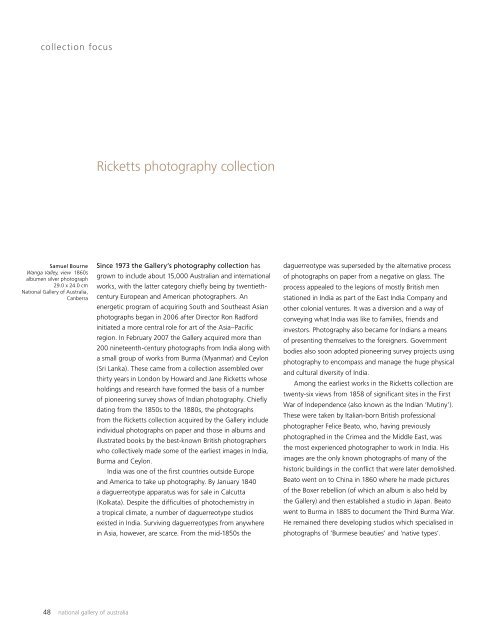Art Ew - National Gallery of Australia
Art Ew - National Gallery of Australia
Art Ew - National Gallery of Australia
You also want an ePaper? Increase the reach of your titles
YUMPU automatically turns print PDFs into web optimized ePapers that Google loves.
collection focus<br />
Samuel Bourne<br />
Wanga Valley, view 1860s<br />
albumen silver photograph<br />
29.0 x 24.0 cm<br />
<strong>National</strong> <strong>Gallery</strong> <strong>of</strong> <strong>Australia</strong>,<br />
Canberra<br />
48 national gallery <strong>of</strong> australia<br />
Ricketts photography collection<br />
Since 1973 the <strong>Gallery</strong>’s photography collection has<br />
grown to include about 15,000 <strong>Australia</strong>n and international<br />
works, with the latter category chiefly being by twentiethcentury<br />
European and American photographers. An<br />
energetic program <strong>of</strong> acquiring South and Southeast Asian<br />
photographs began in 2006 after Director Ron Radford<br />
initiated a more central role for art <strong>of</strong> the Asia–Pacific<br />
region. In February 2007 the <strong>Gallery</strong> acquired more than<br />
200 nineteenth-century photographs from India along with<br />
a small group <strong>of</strong> works from Burma (Myanmar) and Ceylon<br />
(Sri Lanka). These came from a collection assembled over<br />
thirty years in London by Howard and Jane Ricketts whose<br />
holdings and research have formed the basis <strong>of</strong> a number<br />
<strong>of</strong> pioneering survey shows <strong>of</strong> Indian photography. Chiefly<br />
dating from the 1850s to the 1880s, the photographs<br />
from the Ricketts collection acquired by the <strong>Gallery</strong> include<br />
individual photographs on paper and those in albums and<br />
illustrated books by the best-known British photographers<br />
who collectively made some <strong>of</strong> the earliest images in India,<br />
Burma and Ceylon.<br />
India was one <strong>of</strong> the first countries outside Europe<br />
and America to take up photography. By January 1840<br />
a daguerreotype apparatus was for sale in Calcutta<br />
(Kolkata). Despite the difficulties <strong>of</strong> photochemistry in<br />
a tropical climate, a number <strong>of</strong> daguerreotype studios<br />
existed in India. Surviving daguerreotypes from anywhere<br />
in Asia, however, are scarce. From the mid-1850s the<br />
daguerreotype was superseded by the alternative process<br />
<strong>of</strong> photographs on paper from a negative on glass. The<br />
process appealed to the legions <strong>of</strong> mostly British men<br />
stationed in India as part <strong>of</strong> the East India Company and<br />
other colonial ventures. It was a diversion and a way <strong>of</strong><br />
conveying what India was like to families, friends and<br />
investors. Photography also became for Indians a means<br />
<strong>of</strong> presenting themselves to the foreigners. Government<br />
bodies also soon adopted pioneering survey projects using<br />
photography to encompass and manage the huge physical<br />
and cultural diversity <strong>of</strong> India.<br />
Among the earliest works in the Ricketts collection are<br />
twenty-six views from 1858 <strong>of</strong> significant sites in the First<br />
War <strong>of</strong> Independence (also known as the Indian ‘Mutiny’).<br />
These were taken by Italian-born British pr<strong>of</strong>essional<br />
photographer Felice Beato, who, having previously<br />
photographed in the Crimea and the Middle East, was<br />
the most experienced photographer to work in India. His<br />
images are the only known photographs <strong>of</strong> many <strong>of</strong> the<br />
historic buildings in the conflict that were later demolished.<br />
Beato went on to China in 1860 where he made pictures<br />
<strong>of</strong> the Boxer rebellion (<strong>of</strong> which an album is also held by<br />
the <strong>Gallery</strong>) and then established a studio in Japan. Beato<br />
went to Burma in 1885 to document the Third Burma War.<br />
He remained there developing studios which specialised in<br />
photographs <strong>of</strong> ‘Burmese beauties’ and ‘native types’.

















